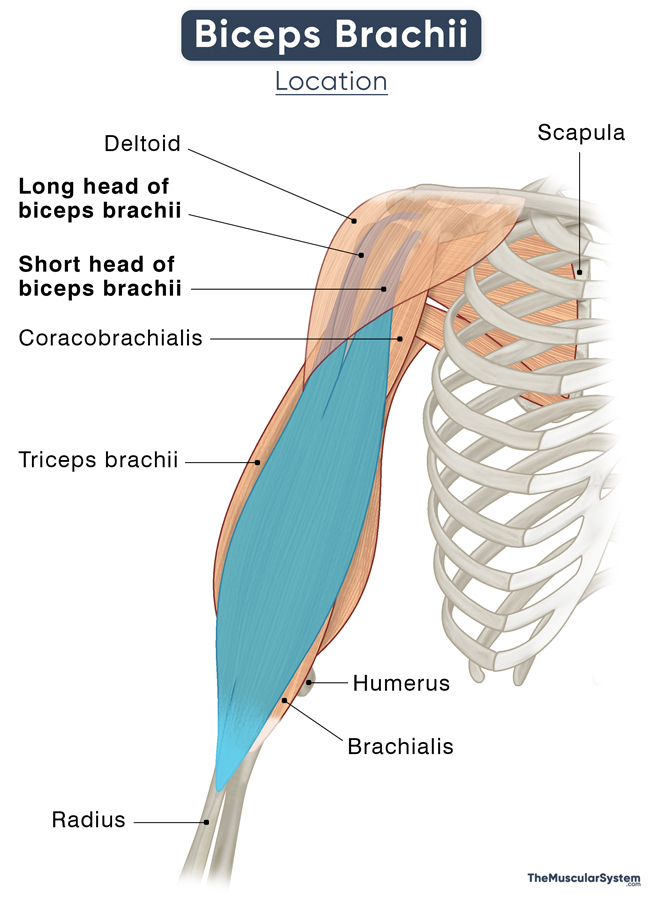Biceps Brachii
Last updated:
20/05/2025Della Barnes, an MS Anatomy graduate, blends medical research with accessible writing, simplifying complex anatomy for a better understanding and appreciation of human anatomy.
What is the Biceps Brachii Muscle
Biceps brachii is one of the primary flexor muscles in the arm, involved in the functioning of both the elbow and shoulder. Its name, ‘biceps,’ is derived from its two heads.
Location and Anatomy
Being a flexor, it is located in the anterior compartment of the arm.
| Origin | Short head: Apex of the coracoid process of scapula Long head: Supraglenoid tubercle of scapula |
| Insertion | The radial tuberosity, and the bicipital aponeurosis into the forearm’s deep fascia |
The short head partially blends with the coracobrachialis muscle tendon at its origin.
The long head has a much longer course, originating at the supraglenoid tubercle, just above the glenoid cavity. It then runs through the rotator cuff interval and turns sharply at the humerus head, continuing down through the bicipital groove (the space between the biceps and triceps). The point where the long head of the biceps turns downwards is held in place by ligaments at the shoulder capsular area.
The two heads join together to form a single muscle belly above the elbow. It then goes on to insert into the radial tuberosity of the radius bone. The distal part of the muscle gives rise to a fibrous membrane known as bicipital aponeurosis, which inserts into the deep fascia of the forearm.
The origin tendons of both the short and long heads of the biceps lay covered by the deltoid muscle. However, the muscle belly lies on the anterior side of the forearm, in front of the other two flexors in the anterior compartment, the brachialis and coracobrachialis. So, the biceps can be easily seen and felt on this side of the arm.
The two bicipital grooves, the hollow spaces between the biceps and triceps, allow passage to the brachial artery and the ulnar, median, and radial nerves.
Functions
| Action | Flexing the forearm Supinating the forearm at the elbow Abducting and flexing (weakly) the arm at the shoulder |
The biceps brachii is a biarticular muscle attached to two joints – the elbow and shoulder.
In the Elbow Joint
The biceps helps in the supination of the forearm, which means rotating it outwards so the hand faces upward. The primary functioning of the muscle happens when the arm is in this position. It assists in bending or flexing the forearm.
In the Shoulder Joint
It also has many weaker functions at the shoulder (glenohumeral) joint. Here, the long and short heads may take part in opposite actions. The long head helps lift the arm away from the body (abduction), while the short head helps pull the arm back towards the body (adduction).
Due to its attachment to the scapula, the short head of the biceps helps keep the shoulder joint stable when carrying something heavy with your arms. The long head assists in holding the head of the humerus in place in the glenoid cavity.
Biceps’ antagonist muscle is the triceps brachii, the extensor in the arm’s posterior compartment. The two work in pairs to flex and extend the elbow.
Innervation
| Nerve | The musculocutaneous nerve with its roots in the spinal nerves C5 and C6 (a terminal brachial plexus branch) |
It shares its nerve supply with the brachialis and coracobrachialis muscles.
Blood Supply
| Artery | Muscular branches of the brachial artery |
References
- Biceps Brachii – Attachments, Action & Innervation: GetBodySmart.com
- Anatomy, Shoulder and Upper Limb, Biceps Muscle: NCBI.NLM.NIH.gov
- Biceps Brachii: HealthLine.com
- Biceps Brachii Muscle: KenHub.com
- Biceps Brachii Muscle: RadioPaedia.org
- Biceps Brachii: Anatomy, Function & Location: Study.com
Della Barnes, an MS Anatomy graduate, blends medical research with accessible writing, simplifying complex anatomy for a better understanding and appreciation of human anatomy.
- Latest Posts by Della Barnes, MS Anatomy
-
Extensor Digitorum Brevis
- -
Extensor Hallucis Brevis
- -
Posterior Compartment of the Leg
- All Posts







